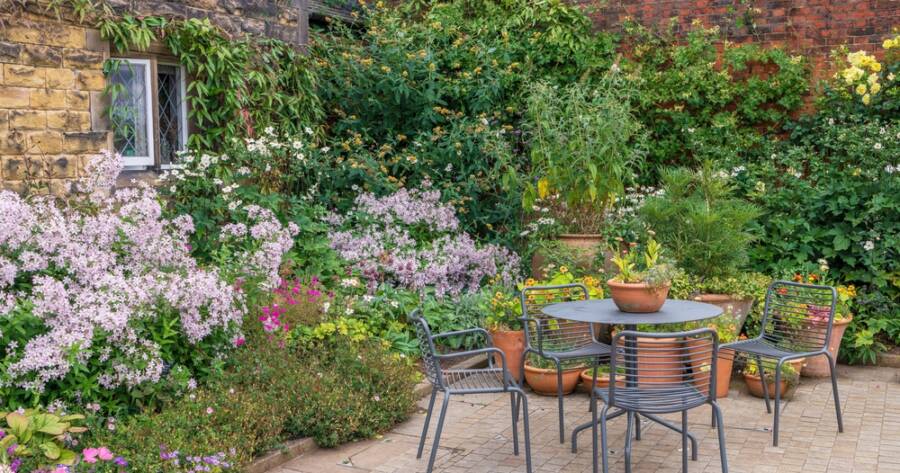As droughts and water shortages affect more regions across the European Union, sustainable garden design is becoming essential. One time-tested solution lies in the heart of the Mediterranean: the courtyard. Traditionally found in Spain, Italy, Greece, and southern France, enclosed garden spaces are more than just beautiful — they’re incredibly efficient. Designed to stay cool and lush with minimal water use, Mediterranean courtyards offer a smart and stylish way to create a green space that respects the environment.
The Beauty of Form and Function
Mediterranean courtyards are known for their charm — whitewashed walls, patterned tiles, potted plants, and cozy shaded corners. But every element has a purpose. These spaces were developed to adapt to hot, dry climates. The walls help block wind and trap cool air, while the hardscaping (like stone floors or clay tiles) reflects sunlight and reduces the need for thirsty lawns.
Water use is minimized by grouping plants in containers or small beds that can be hand-watered with precision. These courtyards often use traditional features like terracotta pots, low fountains, and shaded pergolas to create microclimates where both people and plants can thrive, even in extreme heat.
This combination of function and beauty makes the Mediterranean courtyard ideal for modern EU homes — especially in urban or suburban areas with limited space and growing interest in climate-smart living.
Smart Plant Choices for Dry Conditions
One of the keys to a successful Mediterranean-style courtyard is plant selection. Instead of water-intensive grass or tropical greenery, these gardens rely on hardy, drought-tolerant species that can survive long dry spells.
Popular options include lavender, rosemary, sage, thyme, and oregano — all fragrant, low-maintenance herbs that thrive in dry soil. Olive trees, cypress, and pomegranate also bring character to a courtyard without requiring much water. For ground cover, creeping thyme or drought-tolerant succulents add texture and color.
Potted plants are a central feature of this design. They allow for easy watering, protect roots from overheating, and make it simple to rearrange the space. Using porous terracotta pots helps regulate soil moisture and keeps roots from becoming waterlogged.
Shading is also essential. Climbing vines like jasmine or bougainvillea can grow along walls or pergolas, providing shelter for more delicate plants and keeping the area cooler overall.
Layout and Materials That Work Together
Traditional Mediterranean courtyards avoid large open lawns or shallow flowerbeds that require constant watering. Instead, they focus on defined zones and layered textures.
Paved areas — using stone, tile, or gravel — keep maintenance low and help direct water runoff to planted areas. These surfaces can also reduce evaporation, especially when shaded. Raised beds or built-in planters can be added along walls to frame the courtyard while conserving water.
Many designs incorporate a small water feature, like a shallow fountain or basin. These features don’t waste water when properly maintained and can help create a cooler atmosphere through gentle evaporation. In drier regions, they are often recirculating systems that run on minimal energy.
Pergolas, fabric shades, or overhanging trees offer partial cover, reducing direct sun and creating a pleasant space to sit, dine, or relax. These structures also help shield plants from the harshest sunlight, extending the life of blooms and leaves.
Reusing Water and Maximizing Efficiency
A big part of the Mediterranean courtyard’s water-saving success comes from how water is used and reused. Collecting rainwater is one traditional method that’s still useful today. Placing a rain barrel near downspouts or beneath pergolas can provide a regular supply for hand-watering plants.
Some modern courtyard setups include drip irrigation systems designed to deliver water slowly and directly to plant roots. These systems are highly efficient and can be connected to timers or moisture sensors to avoid overwatering.
Greywater — lightly used water from sinks or showers — can also be repurposed for irrigation with the right filtering and guidance under EU regulations. Combining these methods ensures that every drop of water goes further, even in homes without access to larger-scale rain catchment systems.
Bringing Southern Wisdom North
The Mediterranean courtyard is more than a style — it’s a sustainable strategy shaped by centuries of experience in dry climates. With careful planning and the right plant choices, this design can be adapted to any part of the EU, helping households conserve water without sacrificing comfort or beauty.
As more regions face water scarcity, adopting courtyard-inspired layouts can make home gardens not only more resilient but more inviting. Whether you live in the heart of Athens or a village outside Brussels, this ancient approach offers a refreshing way to create green spaces that truly work with nature.

